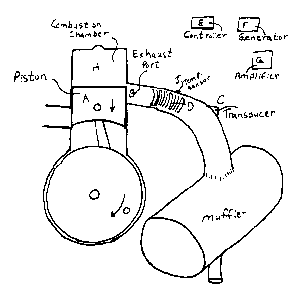Une partie des informations de ce site Web a été fournie par des sources externes. Le gouvernement du Canada n'assume aucune responsabilité concernant la précision, l'actualité ou la fiabilité des informations fournies par les sources externes. Les utilisateurs qui désirent employer cette information devraient consulter directement la source des informations. Le contenu fourni par les sources externes n'est pas assujetti aux exigences sur les langues officielles, la protection des renseignements personnels et l'accessibilité.
L'apparition de différences dans le texte et l'image des Revendications et de l'Abrégé dépend du moment auquel le document est publié. Les textes des Revendications et de l'Abrégé sont affichés :
| (12) Demande de brevet: | (11) CA 2220858 |
|---|---|
| (54) Titre français: | SYSTEME DE CONTROLE PRECIS D'ADMISSION/D'ECHAPPEMENT D'UN MOTEUR A COMBUSTION INTERNE |
| (54) Titre anglais: | A PRECISE, CONTROLLED EXHAUST/INTAKE SYSTEM FOR THE INTERNAL COMBUSTION ENGINE |
| Statut: | Réputée abandonnée et au-delà du délai pour le rétablissement - en attente de la réponse à l’avis de communication rejetée |
| (51) Classification internationale des brevets (CIB): |
|
|---|---|
| (72) Inventeurs : |
|
| (73) Titulaires : |
|
| (71) Demandeurs : |
|
| (74) Agent: | |
| (74) Co-agent: | |
| (45) Délivré: | |
| (22) Date de dépôt: | 1998-01-19 |
| (41) Mise à la disponibilité du public: | 1999-07-19 |
| Requête d'examen: | 1999-08-03 |
| Licence disponible: | S.O. |
| Cédé au domaine public: | S.O. |
| (25) Langue des documents déposés: | Anglais |
| Traité de coopération en matière de brevets (PCT): | Non |
|---|
| (30) Données de priorité de la demande: | S.O. |
|---|
This invention consists of the necessary parts such as a
transducer, amplifier, generator and accompanying sensors, hardware,
software to create a precisely timed sonic/sound wave/pulse capable of
compressing and influencing the movement of gasses within the confines
of an internal combustion engine - especially its exhaust/intake system.
Note : Les revendications sont présentées dans la langue officielle dans laquelle elles ont été soumises.
Note : Les descriptions sont présentées dans la langue officielle dans laquelle elles ont été soumises.

2024-08-01 : Dans le cadre de la transition vers les Brevets de nouvelle génération (BNG), la base de données sur les brevets canadiens (BDBC) contient désormais un Historique d'événement plus détaillé, qui reproduit le Journal des événements de notre nouvelle solution interne.
Veuillez noter que les événements débutant par « Inactive : » se réfèrent à des événements qui ne sont plus utilisés dans notre nouvelle solution interne.
Pour une meilleure compréhension de l'état de la demande ou brevet qui figure sur cette page, la rubrique Mise en garde , et les descriptions de Brevet , Historique d'événement , Taxes périodiques et Historique des paiements devraient être consultées.
| Description | Date |
|---|---|
| Inactive : CIB de MCD | 2006-03-12 |
| Demande non rétablie avant l'échéance | 2003-12-08 |
| Inactive : Morte - Aucune rép. dem. par.30(2) Règles | 2003-12-08 |
| Inactive : Abandon. - Aucune rép dem par.30(2) Règles | 2002-12-09 |
| Inactive : Dem. de l'examinateur par.30(2) Règles | 2002-06-07 |
| Inactive : Page couverture publiée | 1999-10-06 |
| Lettre envoyée | 1999-08-17 |
| Inactive : Correspondance - Formalités | 1999-08-03 |
| Inactive : Conformité - Formalités: Réponse reçue | 1999-08-03 |
| Requête d'examen reçue | 1999-08-03 |
| Toutes les exigences pour l'examen - jugée conforme | 1999-08-03 |
| Exigences pour une requête d'examen - jugée conforme | 1999-08-03 |
| Demande publiée (accessible au public) | 1999-07-19 |
| Inactive : Incomplète | 1999-06-15 |
| Inactive : CIB attribuée | 1998-03-21 |
| Inactive : CIB attribuée | 1998-03-21 |
| Symbole de classement modifié | 1998-03-21 |
| Inactive : CIB en 1re position | 1998-03-21 |
| Exigences de dépôt - jugé conforme | 1998-02-04 |
| Inactive : Certificat de dépôt - Sans RE (Anglais) | 1998-02-04 |
| Demande reçue - nationale ordinaire | 1998-02-03 |
Il n'y a pas d'historique d'abandonnement
Le dernier paiement a été reçu le 2002-12-23
Avis : Si le paiement en totalité n'a pas été reçu au plus tard à la date indiquée, une taxe supplémentaire peut être imposée, soit une des taxes suivantes :
Les taxes sur les brevets sont ajustées au 1er janvier de chaque année. Les montants ci-dessus sont les montants actuels s'ils sont reçus au plus tard le 31 décembre de l'année en cours.
Veuillez vous référer à la page web des
taxes sur les brevets
de l'OPIC pour voir tous les montants actuels des taxes.
| Type de taxes | Anniversaire | Échéance | Date payée |
|---|---|---|---|
| Taxe pour le dépôt - petite | 1998-01-19 | ||
| Requête d'examen - petite | 1999-08-03 | ||
| 1999-08-03 | |||
| TM (demande, 2e anniv.) - petite | 02 | 2000-01-19 | 1999-12-06 |
| TM (demande, 3e anniv.) - petite | 03 | 2001-01-19 | 2000-12-01 |
| TM (demande, 4e anniv.) - petite | 04 | 2002-01-21 | 2002-01-15 |
| TM (demande, 5e anniv.) - petite | 05 | 2003-01-20 | 2002-12-23 |
Les titulaires actuels et antérieures au dossier sont affichés en ordre alphabétique.
| Titulaires actuels au dossier |
|---|
| LLOYD TAYLOR |
| Titulaires antérieures au dossier |
|---|
| S.O. |